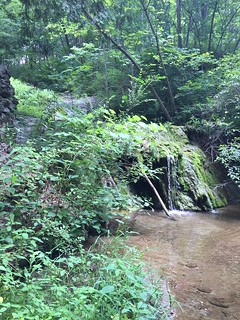Keeping an eye on online identity, privacy, and security.
OCT
2007
This is MatchMine
An exercise in making a dream into reality -- and a parable of flying too close to the sun.
 An unfortunate side effect of pulling down the matchmine servers is that the page describing the history of the company I founded dropped off the map. As I often find myself retelling the origin story, I thought I might as well post the tale as it was undoubtedly an interesting path from genesis to its untimely end.
An unfortunate side effect of pulling down the matchmine servers is that the page describing the history of the company I founded dropped off the map. As I often find myself retelling the origin story, I thought I might as well post the tale as it was undoubtedly an interesting path from genesis to its untimely end.
It all started back in 1995 when my brother, Mark, and I were playing around with this new thing called MP3 streaming. He had founded a biotech startup in Boston and his staff (a motley crew of bioinformaticists) kept eating up server space with their audio library. Further compounding the problem, they'd share their music files which would mean multiple copies all over the place. Let's ignore the legality of this for now (since I'm an ardent supporter of IPR), and focus on the technical side of the story.
As Mark is a total hacker (in the "constant tinkering of a maven" sense of the term), he worked with some similar folks at MIT to create a shared music jukebox. In this way, everyone loaded their music into a central server and could listen to the full collection from their desks. The trick quickly became not "how" to listen to their music, but "what" music to listen to.
At night, then, Mark and I would bounce ideas around for how to build effective playlists. It's no surprise that since Mark's doctorate is in cell molecular biology (i.e. he's a genetic engineer), we homed in on methods for encoding musical interests as a sort of "musical DNA". The concept was to start with human D.J.s as the seeds, analyze their playlists and map their attributes. From there we'd be able to take a couple divergent playlists and replicate them (with pattern deviations) to create variants. Closing the loop would be the listeners who "voted" which playlists they liked so that the feedback would identify the successful mutations (allowing the others to fall out of the music gene pool).
Anyone who has the pleasure of meeting Mark will know the next part of the story. Once the idea was fleshed out, and the proof of concept built, the spark was gone from the project. He's much more interested in what hasn't been done, yet, and making it come alive. Next on the list? Building what I believe to be the first in-dash car MP3 player. The list of ingredients? An old laptop mounted in the trunk and a Nintendo controller wired into the dashboard. Oh, and enough duct tape and bailing wire to make Macgyver proud.
Fast forward 10 years and you'll find me in Jonathan Kraft's office telling this story. As the Chief Innovator for the Kraft Group Sports Properties at the time, I was responding to a request Jonathan had about expanding his digital media empire. He was exploring the possibility that we could take the production and distribution model I'd helped create for KGSP and roll it out as, essentially, an online media network akin to NBC, ABC, etc.
While seemingly a huge undertaking, Jonathan is not known for shying away from a big idea (with an associated enormous potential for revenue). Fortunately, Fred Kirsch (the KGSP Director of Interactive Media) and I had spent the past seven years building the foundation for the effort. By 2005 we were producing over 74 hours of digital media programming per week. Further, it was being distributed via multiple channels from various websites to the NFL Network, in Comcast On-Demand, through Gotuit's network, and over-the-air on local stations.
With all that as background, my comment in that October 2005 meeting was that the effort to move beyond the essentially captive New England sports market would be significantly different than what we'd been doing. The model for the production and distribution pipeline would largely be the same, but the marketing and business models would need to be rebuilt from scratch. Further, the shift in scale may not map to our proven model.
My suggestion, then, was that the true opportunity wasn't in producing new content (there's enough of that already), but rather in connecting consumers with existing media matching their interests. When I brought up the story about my brother and I tinkering with the music DNA concept, I sketched out how a similar model could be applied to just about any consumable media. I'd adopted more of an n-space model and associated metaphor rooted in my training as an astrophysicist, but the re-factored concept was largely similar to it's progenitor.
Apparently, Jonathan and Robert Kraft liked the idea since the next thing I know, they've asked me to assemble a team to start developing the technology. It was one of those incredible moments in which every emotional reaction coursed through my veins at once. I was simultaneously elated that they liked my idea, while being terrified I'd screw it up, to sad I'd be leaving some projects incomplete (e.g. a semantically remodeled e-commerce system), and simply excited with the pure newness of the project. It wasn't just something new for me, it was an entirely new solution to an emerging problem of media overload.
In fact, the solution I mapped out broke even more ground. It wasn't only media agnostic, but cross-system compatible... and the most unique idea at the time: it was a portable mechanism that was entirely under the control of the end user. Thus was born what was eventually marketed as the MatchKey and the associated support machinery we called the Matchmine Discovery Network.
It was one thing to come up with the idea, but it was entirely another to make it a reality. My first step was to hire a series of consultants who live deep inside the beltway working on data modeling for our friends the three-letter agencies. Through their work we were able to see a clear path to a solution, and I began hiring architects and engineers to build it. So far, we were all camped in offices built directly under the stands of Gillette Stadium, physically separated from the rest of the KGSP operation due to legal requirements for protecting IP.
With more meat on the bones of the initial idea, it was time to turn our eye on making it commercially viable. Enter the amazing team we hired to form matchmine, the company that turned the idea into a business. And to define and run that business we tapped Mike Troiano to be the CEO. Hunkered down in the stadium in September 2006 we started working out the business details. Through his leadership we mapped out a strategy, moved into compatible office space in Needham, and in 2007 we hit the ground running.
While I was the primary author of the idea, it was really through the amazing work by an incredibly talented team that brought the system to life. In fact, here's a list of folks who I feel deserved much more than a pink slip when we were forced to shut down: Srini, Joachiam, Alvaro, Dave, Denise, Bob, Kathy, Eric, Erik, Susan, David, Dean, Chris, Craig, Tod, Yury, Michelle, Scott, Adam, Jessica, Rob, Tom, Philip, Nathan, Leigh, Irina, Amy, Rajan, and Shawn. My heartfelt thanks to all for their contributions; I wish I could offer you more than a simple acknowledgment.
It's hard to call out specific individuals, as I truly believe it was a team effort, but I'm particularly proud to have had Dr. Jim Butler, Rajan Desai, and Brian Connor on board since the beginning. And even though I played at being the Chief Scientist while we were getting off the ground, it was Dr. Scott Oddo who took my initial algorithms and really made them sing as our VP of Science.
In the end, we achieved what we set out to accomplish. We had successfully encoded user preferences, created uniquely agnostic recommendation algorithms, and deployed the required machinery to empower the full ecosystem in a privacy-respecting, user-controlled manner. It worked, we were connecting consumers with media that matched their interests.
... until the house-of-cards economy collapsed. And unfortunately, we didn't even have time to shop around for an investor to keep the system running before trying to sell the company or assets.
So, there you have the history of an idea. Now, onto the next one, may it turn out to have a longer life.
UPDATE: You might also be interested in the final note on the company posted by Mike on his blog.
